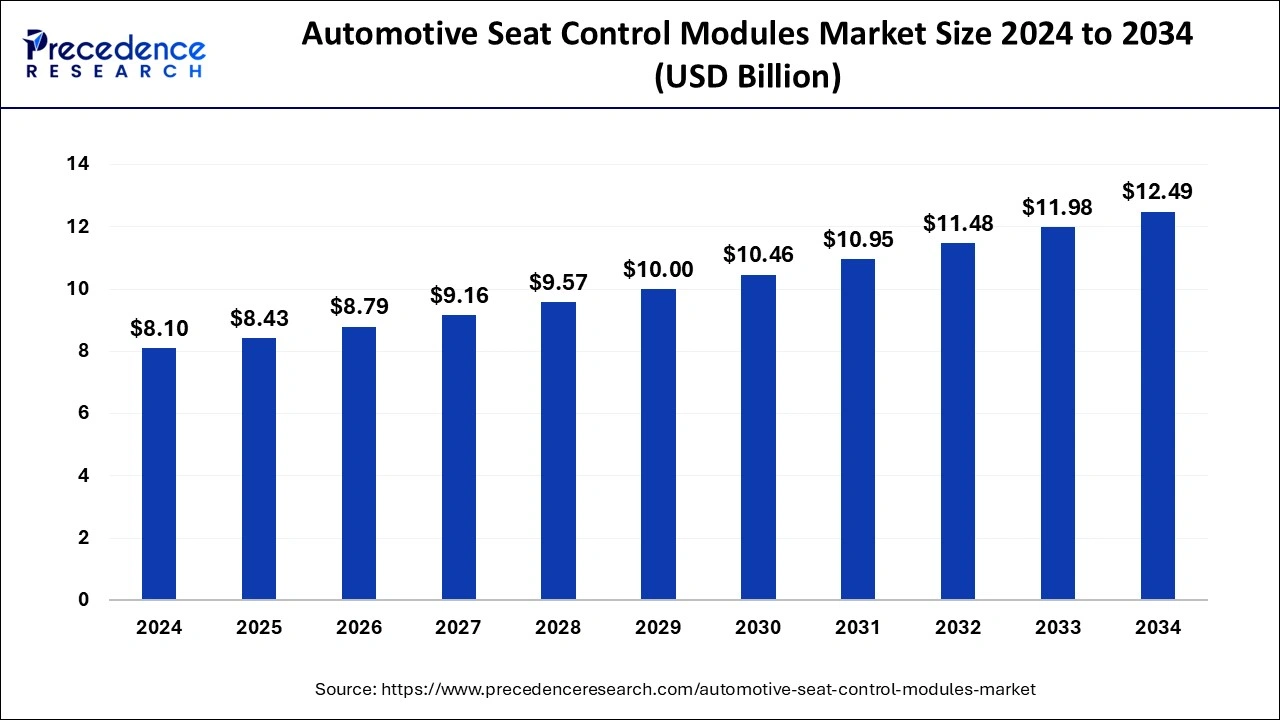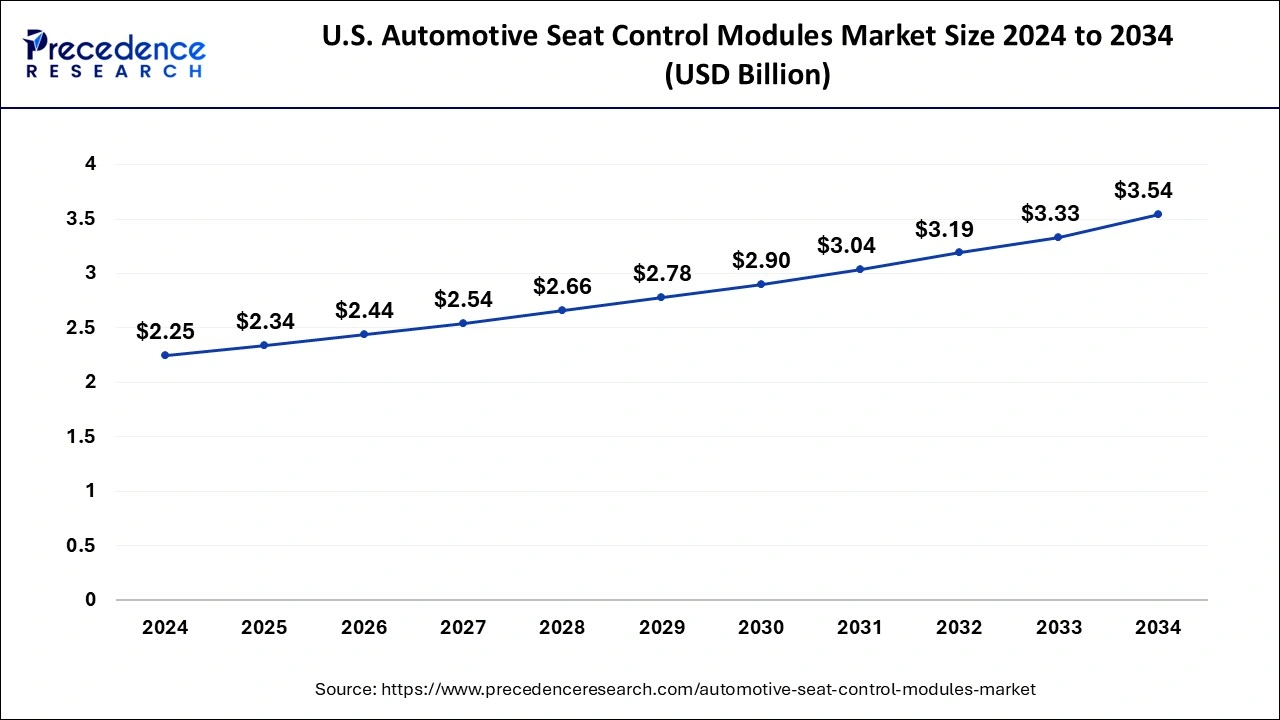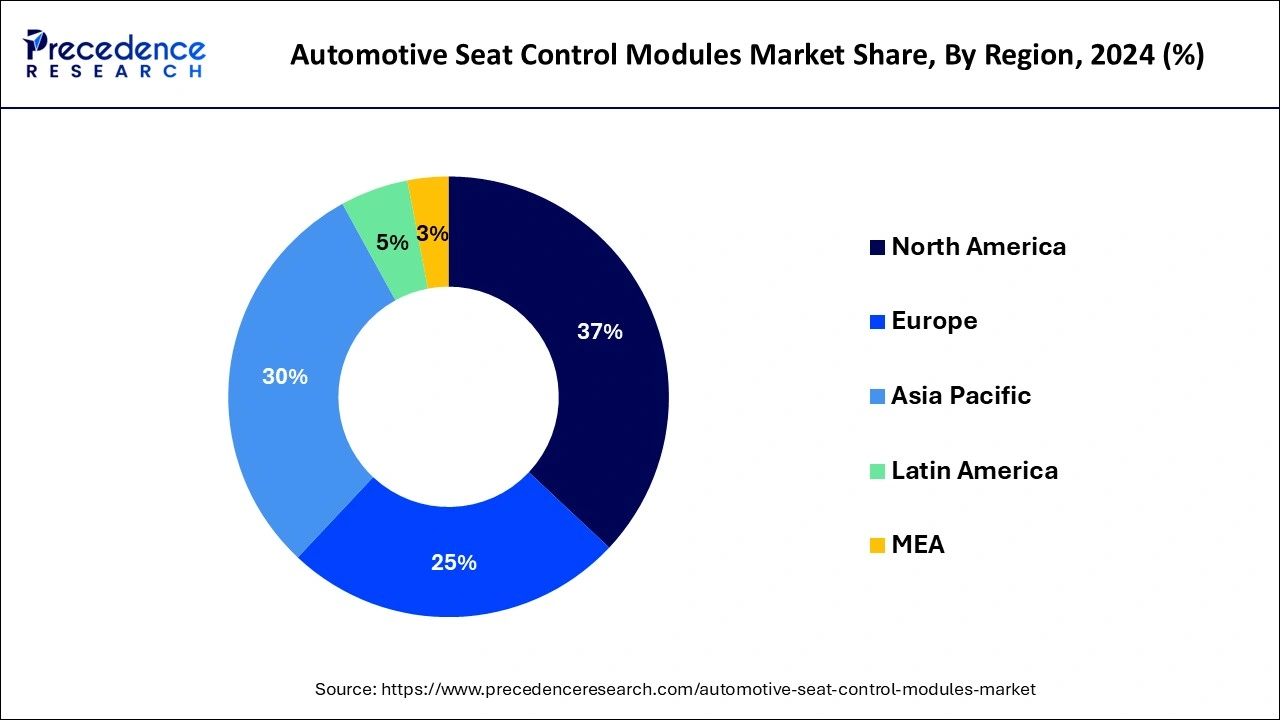January 2025
The global automotive seat control modules market size is calculated at USD 8.43 billion in 2025 and is forecasted to reach around USD 12.49 billion by 2034, accelerating at a CAGR of 4.42% from 2025 to 2034. The North America automotive seat control modules market size surpassed USD 3 billion in 2024 and is expanding at a CAGR of 4.54% during the forecast period. The market sizing and forecasts are revenue-based (USD Million/Billion), with 2024 as the base year.
The global automotive seat control modules market size was estimated at USD 8.10 billion in 2024 and is anticipated to reach around USD 12.49 billion by 2034, expanding at a CAGR of 4.42% from 2025 to 2034. The global automotive seat control modules market is attributed to the increasing trend of long-distance travel in developing regions due to the modernization of road networks and the integration of smartphones with seating systems.

Artificial intelligence is a major and necessary trend in technology. AI-generated software of various companies provides the ideal solution to their customers. Manufacturers achieved exceptional speed and precision in identifying wrinkles across diverse seat materials, through advanced AI technologies. Various companies prioritize providing comprehensive training and exceptional customer support to ensure a seamless experience for their clients. In addition, AI technologies help to identify wrinkle defects and analyze seat materials with high precision. Companies propel their clients towards improved profitability and operational excellence, by empowering employees and automating quality inspection with advanced AI technology. These advanced trends are expected to enhance the growth of the automotive seat control modules market.
The U.S. automotive seat control modules market size was evaluated at USD 2.25 billion in 2024 and is predicted to be worth around USD 3.54 billion by 2034, rising at a CAGR of 4.63% from 2025 to 2034.

North America dominated the automotive seat control modules market with the largest market share of 37% in 2024. The market growth in the region is attributed to the increasing demand for passenger vehicles, increasing demand for comfortable and relaxed seating, and increasing consumer preference towards high-end vehicles.

The U.S. Automotive Seat Control Modules Market Trends
The U.S. dominated the automotive seat control modules industry in 2024. The market growth in the U.S. is attributed to the rising integration of IoT and AI to meet evolving consumer expectations and increasing focus on research and development. The market is experiencing growth in the U.S. To experience exceptional driving clubbed with advanced features, various consumers are demanding more lightweight vehicles. In addition, rising favorable government policies, technological advancements, and the increasing presence of mature offshore oil and gas fields driving the market growth.
Asia Pacific is expected to grow fastest during the forecast period.
The automotive seat control modules market growth is attributed to the increasing government initiatives to drive domestic oil and gas production and rapidly increasing energy demand driving offshore production and exploration activities.
China Automotive Seat Control Modules Market Trends
China is fastest fastest-growing country in the region and is expected to grow the fastest during the forecast period. The market growth in the country is attributed to the increasing popularity of electric vehicles and increasing focus on the production of lightweight materials and safety features. In addition, increasing urbanization and infrastructure development are owing to the increasing demand for transportation facilities in China. Furthermore, the increasing disposable income of more individuals is owing to their increased spending on premium products, such as automobiles in China. These factors are expected to drive the growth of the automotive seat control modules market in China.
Seat control module highlights more on the safety, comfort and seat control system due to rapid progress of automobile sector and electronics technology. These factors gradually converted into imperative consideration for consumers appreciating automobile's comfort. Seat control module can regulate plentiful motors for correcting angle, location, and height of seat to permit drivers set their perfect driving position. The major influences that boost the growth of the automotive body control modules market are upsurge in need for advanced comfort, safety, and expediency features in vehicles; strict guidelines set by governments; and rise in requirement of automotive across the globe. Yet, growing complication is projected to confine the market growth to some extent. Furthermore, the demand for hybrid and electric vehicles and demand for advanced driver assist (ADAS) features are anticipated to deliver lucrative prospects for the development of the global automotive body control modules market during years to come.
| Report Highlights | Details |
| Market Size by 2034 | USD 11.48 Billion |
| Market Size in 2025 | USD 8.43 Billion |
| Market Size in 2024 | USD 8.10 Billion |
| Growth Rate From 2025 to 2034 | CAGR of 4.42% |
| Base year | 2024 |
| Forecast Period | 2025 to 2034 |
| Segments Covered | Type, Application, End User |
| Regional Scope | North America, Europe, Asia Pacific, Latin America, Middle East & Africa (MEA) |
Passenger car is Predicted Grow at Rapid Pace During Years to Come
Among different types of vehicles, passenger car vehicles contributed biggest revenue in 2020. Each light-duty vehicle is mounted with a body control module for appropriate operations of other body control functions. OEMs are fine-tuning the seat control module for their individual vehicle models. Seeing the availability of customization in the vehicles, users are also enthusiastic to go for such vehicle offerings. This is the motive for the growth of the passenger vehicles market in across the globe.
The advent of new-fangled players is predictable to exaggerate competition amongst the existing players during the estimate period. Prominent market contributors are accenting on strategies such as innovative product launch, business development, collaborations and acquisition to withstand the strong market rivalry. Leading competitors contending in global automotive seat control modules market are as follows:
In order to better recognize the current status of acceptance of automotive seat control modules, and policies adopted by the foremost countries, Precedence Research foretold the future evolution of the automotive seat control modules market. This research study offers qualitative and quantitative insights on automotive seat control modules market and assessment of market size and growth trend for probable market segments.
In August 2023, Ford CEO Jim recently announced that Bosch should do the body control module, someone else to do the seat control module, and someone else to do the engine control module. They also said that they have 150 of these modules with semiconductors all through the car.
In April 2023, to offer comfortable seating services, Lear Corporation completed the acquisition of I.G. Bauerhin. The aim behind this launch was to help the company expand its presence in Germany.
In June 2024, a highly anticipated SUV, the Bolero Neo Plus was introduced by Mahindra that promises versatility, comfort, and spaciousness for commercial use and families. This extended version of the popular Bolero Neo is set to redefine the concept of fully-family care, with seating for nine individuals.
By Type
By End-User
By Application
By Geography
For inquiries regarding discounts, bulk purchases, or customization requests, please contact us at sales@precedenceresearch.com
No cookie-cutter, only authentic analysis – take the 1st step to become a Precedence Research client
January 2025
April 2025
January 2024
January 2025